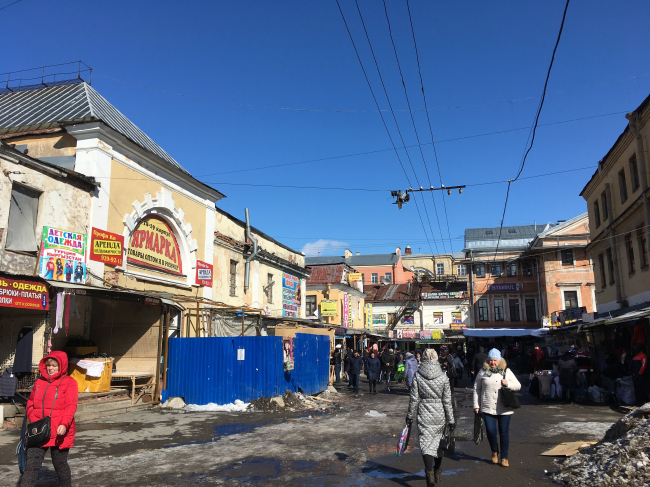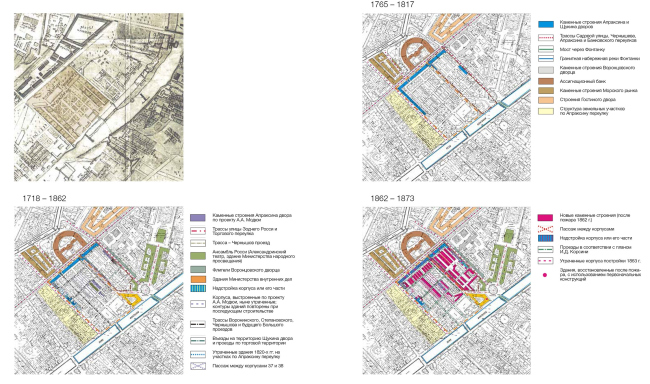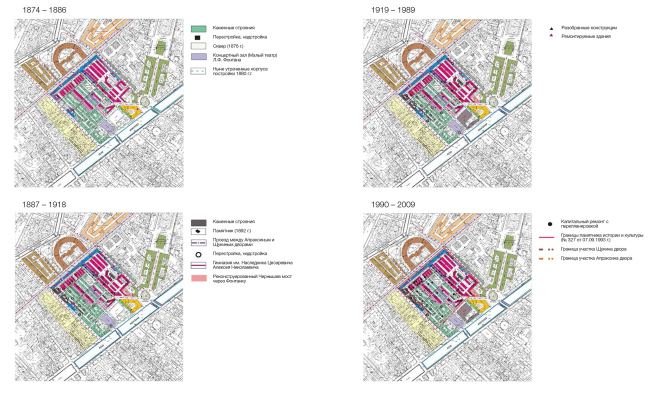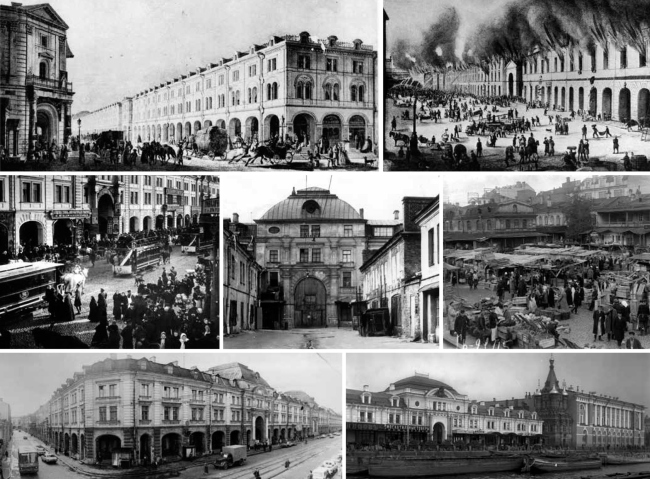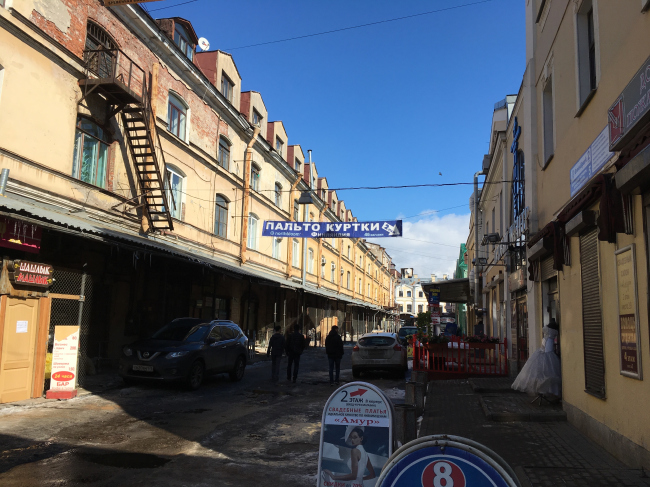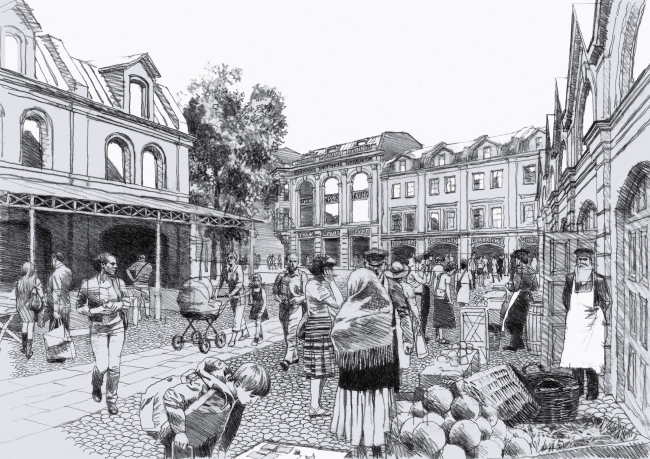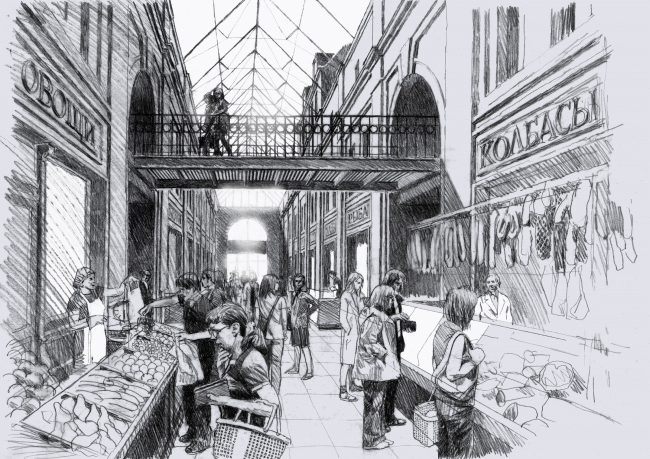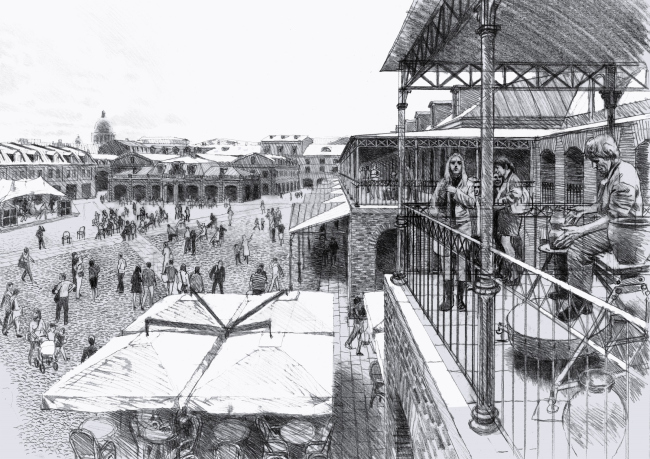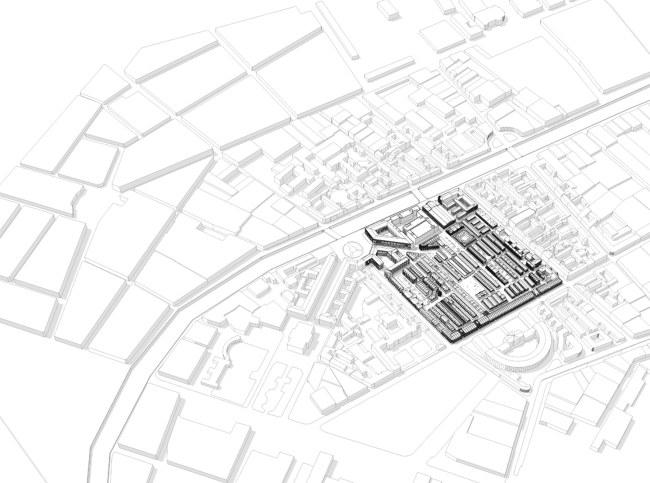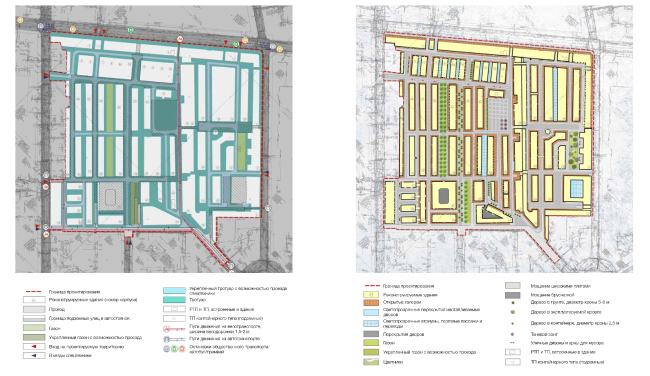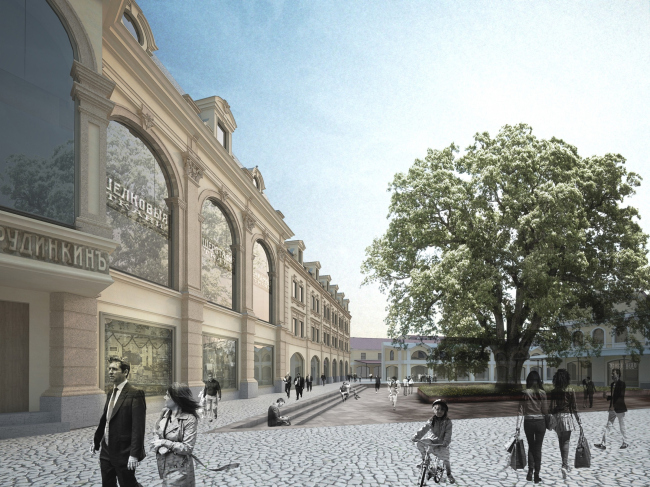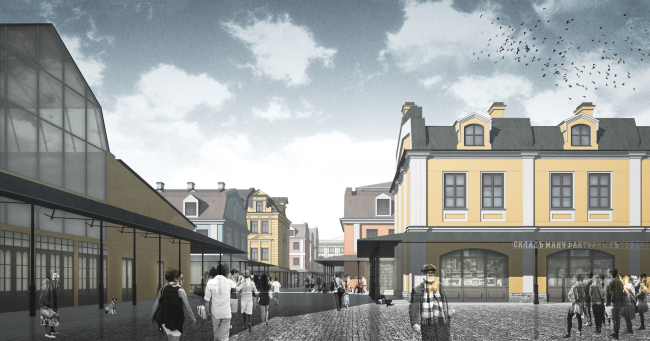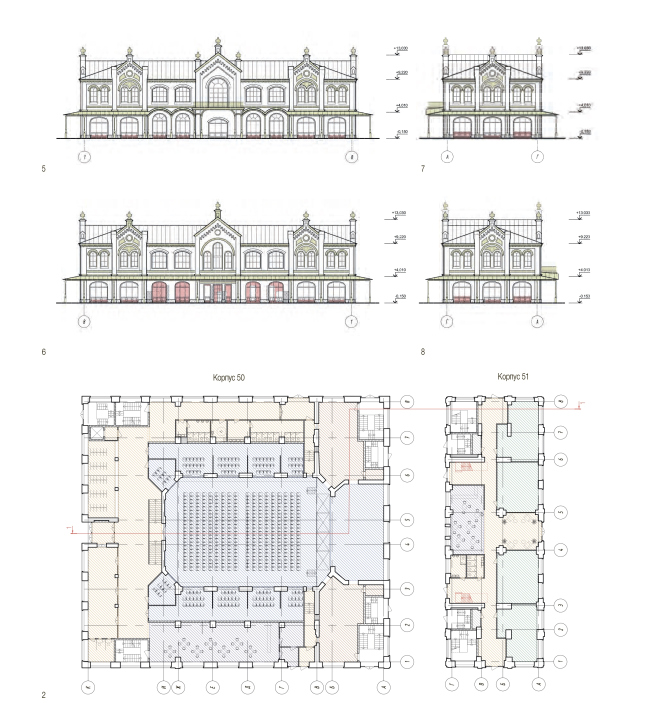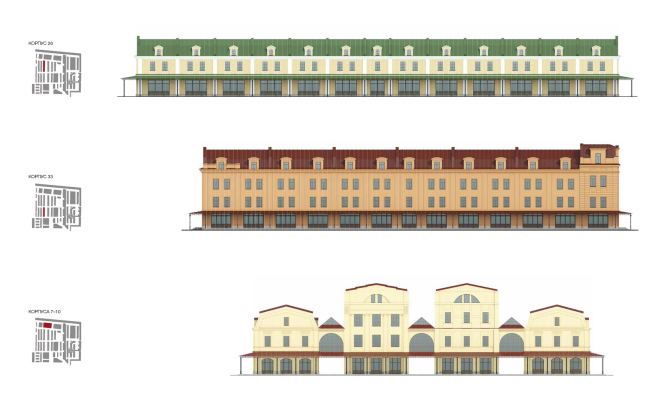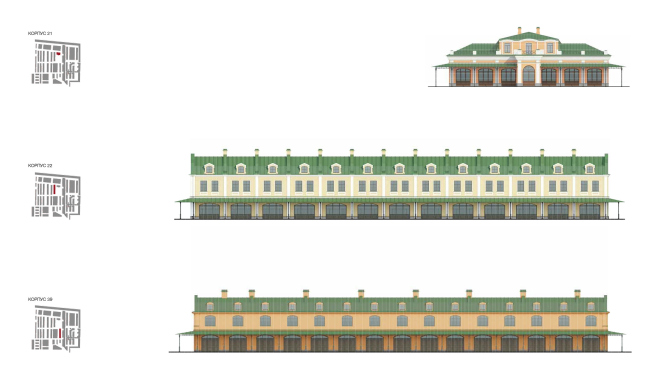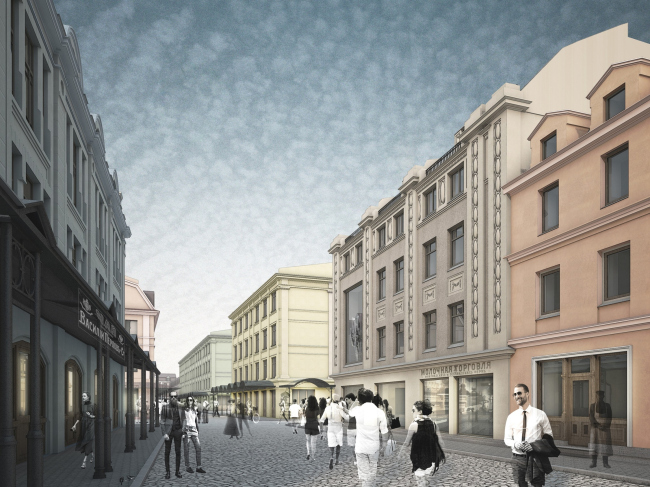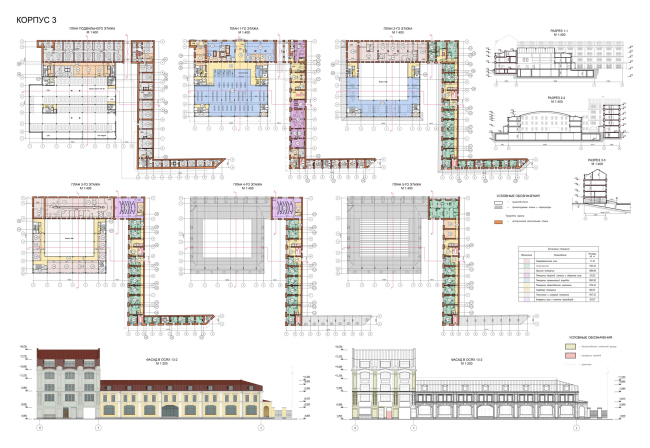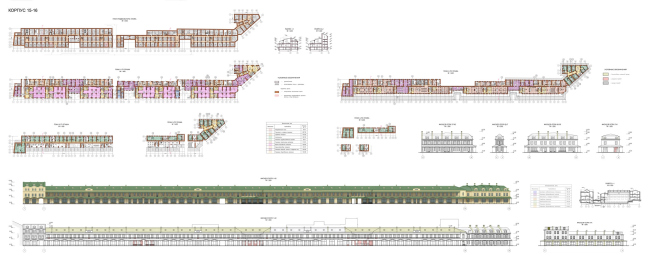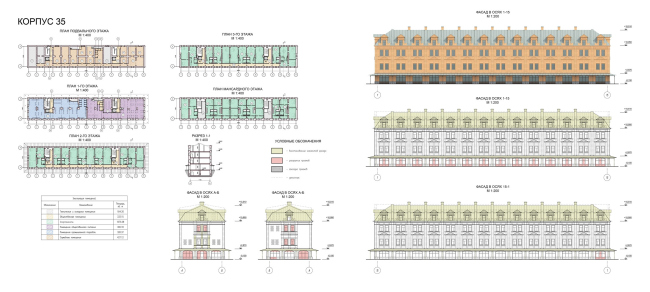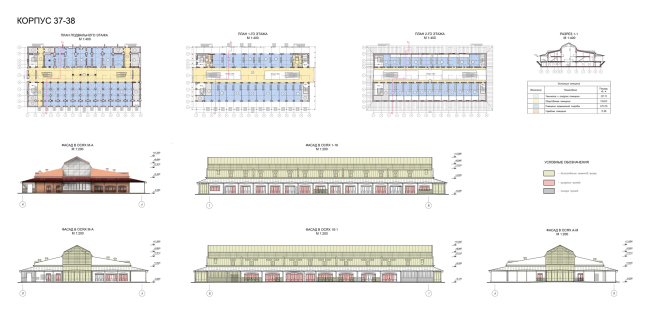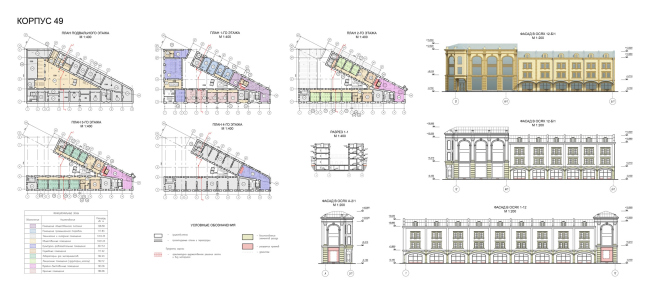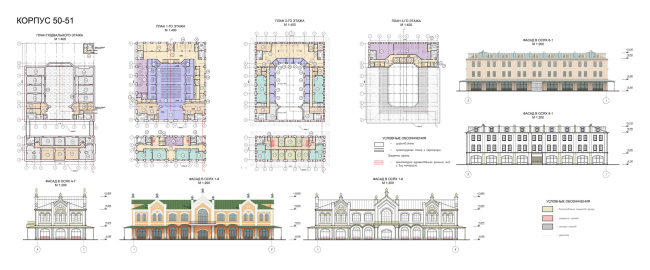|
Published on Archi.ru (https://archi.ru) |
|
| 05.06.2018 | |
|
The Story of Apraksin Dvor |
|
|
Elena Petukhova |
|
| Architect: | |
| Nikita Yavein | |
| Studio: | |
| Company: | |
|
The Saint Petersburg Council for Cultural Heritage Sites has approved of the concept of renovating “Apraksin Dvor” proposed by “Studio 44”. Based on the stage-by-stage tactics of working with the numerous owners of the buildings situated on this land site, the concept provides for a lot of new functions and a pedestrian space with a driving entrance from the underground. Renovation and reorganization to fit modern functions of the regional cultural heritage site "Apraksin Dvor with the Mariinsky Market" © Studio 44The Forgotten Place Many cities have places in them, whose current state is at desperate odds with their potential, and Saint Petersburg in this sense is no exception – the vivid example of that is Konyushenny Dvor or Apraksin Dvor, which forms a gigantic complex with a total area of about 13 hectares, together with the adjacent Shchukin Dvor, aka Mariinski Market. Situated ridiculously close to the city center, next to the Nevsky Prospect, it has been for years falling into decay, putting on outlaw annexes, garish shop signs, and other marks of “wild-growing” environmental design: a huge marketplace from the 1990’s that in fact occupies a cultural heritage building – yes, this place formally received the appropriate status in 1993. The situation, however, is beginning to improve – to a large extent, thanks to the perseverance of “Studio 44”, whose unflagging professional enthusiasm has been helping the architects for decades to put together the puzzle of the owners’ and renters’ interests, deal with the lack of financing, and the absence of the social need for the change. The inner space of Apraksin Dvor. March 2018. Photo: Elena PetukhovaThe Eternal Market The rectangle of Apraksin and Shchukin Dvors is the largest marketplace of the early XIX century, most of these Saint Petersburg markets being grouped around the Sadovaya Street: nearby, one will also find the Morskoy, Sennoy, Nikolsky markets, and, of course, the Gostiny Dvor (the current project of the reconstruction of which, by the way, was also developed by “Studio 44”). All these markets are essentially shopping arcades, the satellites of the development of the capitalist industry, and the once-centers of the economic development. From the XVI to XIX century, their place has always been in the center of the city. Renovation and reorganization to fit modern functions of the regional cultural heritage site "Apraksin Dvor with the Mariinsky Market" © Studio 44Renovation and reorganization to fit modern functions of the regional cultural heritage site "Apraksin Dvor with the Mariinsky Market" © Studio 44The typology of shopping arcades is determined by their function and thus has remained almost unchanged for centuries: the arcades running alongside the perimeter of the building before the entrances to the shops, offices on the second floors, and storage spaces in the middle. If the courtyard was a big one, it would also get inside shopping streets. If a simpler structure was designed to become the shopping arcade, a city market that just consisted of rows of counters, the construction was done in stages. As the tradesmen would grow richer and quite often in order to eliminate the fire hazard, the wooden pavilions were replaced by stone ones, the general layout being still preserved. This is how Apraksin Dvor and Shchukin Dvor developed from the mid XVIII century to the late XIX century. At different times, their buildings were handled by numerous architects, some of them being the famous ones, from Eropkin and Korobov to Lidval. By 1917, was arguably the largest market in Europe: over 40 buildings and about 650 shops, sales of furs, broadcloth, groceries, fruits, tea, wine, and more. Renovation and reorganization to fit modern functions of the regional cultural heritage site "Apraksin Dvor with the Mariinsky Market" Photo courtesy by Studio 44After the October Revolution 2017, the shops continued working; the fruit market and the small trade also survived. A different fate was prepared for the land site stretching along the Fontanka River, this land never really belonging to the market anyway: they demolished the Voskresenskaya Church here, replacing it with the building of Lenizdat in 1964, which joined the printing house that already was there. Nearby, again, on the Fontanka waterfront, stands the Tovstonogov Bolshoi Drama Theater, which is in fact the heir of the Count Apraksin Theater; in the XX century, it got a few office buildings that blocked the market’s connection to the waterfront. In the 1990’s, the buildings of “Aprashka” (as people of Saint Petersburg call it) was privatized and partially reconstructed to fit the new owners’ tastes, the lacunae having been filled with small retail shops, without any detailed plan or project. The inner space of Apraksin Dvor. March 2018. Photo: Elena PetukhovaThis is how the expensive marketplace of the ripe capitalism of the XIX century turned into the cheapest place of the city of the XXI century. Choosing between the pleasures of civilized trade and the inexpensive rent of ruined hazard-state premises, the city people opted for the latter. The complex almost fell into a state of “shopping slums”; it is enough to pass it by walking down the Sadovaya Street to feel the unmistakable smell. The Background “Studio 44” launched its first project in the late 1980’s. The period of the history of “Aprashka” started in the mid 2000’s from a string of “star” international competitions. The year of 2007 saw a competition of developer companies for the right to reconstruct and develop Apraksin Dvor. Three companies were vying for this right: OOO “Glavstroy” owned by the billionaire Oleg Deripaska; Russian Land, headed by Shalva Chigirinsky, and the Swedish RURIC AB. Each of the three developers came forward with an architectural proposal of their own. Chigirinsky ordered his concept to Norman Foster, RURIC AB – to Nikita Yavein’s “Studio 44”, and Glavstroy went as far as to organize an invitation-only competition that included Rem Koolhaas, Chris Wilkinson, MRDV, and PRP Architects. Glavstroy’s inner competition was won by Chris Wilkinson, while RUSSIAN LAND and RURIC joined efforts and put forward Foster against Wilkinson. The ultimate victory was won by the Wilkinson concept, which included tearing down the building of Lenizdat, subsequently replacing it with a hotel; a “hovering” glass roof above the square, and a bridge thrown over the Fontanka River. However, neither the almost 30 billion worth of anticipated investment nor the plans to bring the entire block in order within three years helped the concept to overcome the preservation experts’ skepticism and the consequences of the world economic crisis that stopped many investment projects in Saint Petersburg from being implemented. The tender of 2013 included Timur Bashkaev architects and “Studio 44”. – Timur Bashkaev proposed the nominal value for the development of the architectural concept as being 200 000 rubles, planning to preserve the historical look of the façades and opt out of developing the underground space altogether. However, even such economy-class variant was to remain on paper – due to the fact that the problems with the private property owners, whose share in the total area of “Aprashka” amounted to 170 000 square meters (almost 30%), were impossible to solve without some “political will” or financing in the amount sufficient for all these buildings to be bought out by the city from these owners. While the Moscow concept was still being discussed, another Moscow-based company, Glorax Development, in 2015, ordered “Studio 44” a , in which the designers made good on the criticism, first of all, by decreasing the underground part – in the past, the team of Nikita Yavein proposed to make a four-level underground parking garage underneath the entire territory, and, expanding the set of public functions, turn the former marketplace into a housing project with a large pedestrian area. After that, also in 2015, the city council created a joint stock company named “Apraksin Dvor”, handing over to it under trust management about 40 000 square meters of Apraksin Dvor and Shchukin Dvor, the part that belonged to the city and was free from the investment contracts. The joint stock company is meant to implement the plans of , preserving the cultural heritage sites, and launching the investment process aimed at adjusting the place for modern use. In 2017, in order to select the developer of the sketch design project, Apraksin Dvor organized a tender that was won by “Studio 44”. Four months later, in October of 2017, the concept designed by Nikita Yavein was approved by the Renovation and reorganization to fit modern functions of the regional cultural heritage site "Apraksin Dvor with the Mariinsky Market" © Studio 44Renovation and reorganization to fit modern functions of the regional cultural heritage site "Apraksin Dvor with the Mariinsky Market" © Studio 44The Fifth Crusade The concept that was submitted and finally approved by the Council is “Studio 44”’s fourth attempt to radically change the situation with one of the largest architectural ensembles of the center of Saint Petersburg that has for decades been falling into decay. Such perseverance and faithfulness to the chosen cause is nothing but amazing. Participating in contests, full-scale survey, analysis of each of the buildings, development of engineering and construction solutions for the ruined infrastructure, negotiations with the city authorities and property owners, round after round, without any external financing, solely at the company’s expense… One will hardly remember any other examples of such “crusades” in the history of modern Russian architecture. Renovation and reorganization to fit modern functions of the regional cultural heritage site "Apraksin Dvor with the Mariinsky Market" © Studio 44Renovation and reorganization to fit modern functions of the regional cultural heritage site "Apraksin Dvor with the Mariinsky Market" © Studio 44Renovation and reorganization to fit modern functions of the regional cultural heritage site "Apraksin Dvor with the Mariinsky Market" © Studio 44Renovation and reorganization to fit modern functions of the regional cultural heritage site "Apraksin Dvor with the Mariinsky Market" © Studio 44Principles and Methods The current proposal by “Studio 44” is not so much a project as a whole new program of functional and town-planning reorganization of the territory and turning it into a full-fledged city block with developed infrastructure worthy of being a neighbor of the Nevsky Prospect. People will live and work here; they will be able to do some shopping, go to a theater performance or an art exhibition. Renovation and reorganization to fit modern functions of the regional cultural heritage site "Apraksin Dvor with the Mariinsky Market" © Studio 44“We developed several principles of renovating this complex, which guarantee the preservation of the historical heritage, at the same time creating a maximally comfortable and efficient infrastructure of a modern city block” – shares Nikita Yavein. 1. A pedestrian city The historical network of driveways 4 to 8 meters wide is not fit for full-fledged city traffic. The optimum solution in this case would be to organize a totally pedestrian zone with a possibility of special vehicles driving in, should such need arise. The territory of “Apraksin Dvor” can in fact turn into one of the largest pedestrian zones of Saint Petersburg. . The pedestrian and vehicale traffic plan. Landscaping. Renovation and reorganization to fit modern functions of the regional cultural heritage site "Apraksin Dvor with the Mariinsky Market" © Studio 44Renovation and reorganization to fit modern functions of the regional cultural heritage site "Apraksin Dvor with the Mariinsky Market" © Studio 442. Developed underground space The project continues and develops the basements of the existing buildings. The only underground floor serves for the loading of the shops and cafes, and provides a driving access to houses and shops that can only be accessed from underground, as well as to a limited-size parking garage for 441–757 parking places, depending on the adopted scenario and financial situation. In the special channels of the underground level, communications will be laid, which will facilitate their repair work. Plan of the basement floor on the -1st level. Version 1. Renovation and reorganization to fit modern functions of the regional cultural heritage site "Apraksin Dvor with the Mariinsky Market" © Studio 44Plan of the basement floor on the -1st and -2nd level. Version 2. Renovation and reorganization to fit modern functions of the regional cultural heritage site "Apraksin Dvor with the Mariinsky Market" © Studio 44Plan of the basement floor on the -1st level. Version 2. Renovation and reorganization to fit modern functions of the regional cultural heritage site "Apraksin Dvor with the Mariinsky Market" © Studio 443. An inhabited town The upper levels of the shop buildings become residential ones, which makes it possible to get rid of the “endless marketplace” and looks more like a medieval guild town with the owners’ residences situated above their shops, which will be the perfect solution for the small business, for example, an antiques store, a doctor’s office or a legal firm. Currently, several developers and realtors already confirmed the popularity of such kind of real estate at the market of Saint Petersburg. Plan of the basement floor on the -1st level. Version 1. Renovation and reorganization to fit modern functions of the regional cultural heritage site "Apraksin Dvor with the Mariinsky Market" © Studio 44The architects tried to find a balance between the retail, public, and residential functions. It often happens that a popular cafe or club turns the life of the upper floor residents into a living hell. For this reason, the project provides for “quiet” streets – residential ones, with a minimum public function – and “loud” ones. The amount of residential premises, including apartment hotels, regular hotels and hostels is approximately equal the sum total of the public spaces: shops, cafes, offices, coworking spaces, services, sport clubs, museums, exhibition halls, and cultural centers. 4. Multifunctional The tilt towards creative industries and travel service is not so much homage to fashion or hopping on the bandwagon but the result of the survey of the market situation: these directions were to help to achieve steady popularity of the residential and nob-residential spaces and buildings. The scheme of functional zoning. Plan of the basement floor on the -1st level. Version 1. Renovation and reorganization to fit modern functions of the regional cultural heritage site "Apraksin Dvor with the Mariinsky Market" © Studio 44Plan of the basement floor on the -1st level. Version 1. Renovation and reorganization to fit modern functions of the regional cultural heritage site "Apraksin Dvor with the Mariinsky Market" © Studio 44In addition, the architects though that it would be a waste not to take the advantage of the proximity of the Tovstonogov Bolshoi Drama Theater and the Vaganova Academy of Russian Ballet, allotting for the theater, musical, and art spaces a few buildings on the Fontanka side. This place will also host the , for which buildings 50 and 51 will be remodeled. In order to preserve the historical look of the buildings, the spectator hall will be placed in their reconstructed mutual yard. However, this experimental stage is the only example of the architects' “intrusion” into the historical city fabric. Readjustment of Buildings 50 and 51 for the experimental stage of the Bolshoi Drama Theater. Renovation and reorganization to fit modern functions of the regional cultural heritage site "Apraksin Dvor with the Mariinsky Market" © Studio 445. Preservation “We don’t tear anything down and we virtually don’t build anything new” – Nikita Yavein says. The cover of the sketch project bears the name of “restoration”. This term is, of course, applied to the historical buildings, and not to the later chaotic additions and other attributes of the "marketplace" period in “Aprashka”’s history. On the basis of the earlier conducted survey, the architects drew up a passport of condition and expected work on every (!) building, with a list of all the changes that took place in its appearance, and a detailed description of restoration work – this work includes, among other things, opening of the bricked-up window apertures, bricking up the “spontaneous” or “outlaw” windows and doors, and recreation of façade elements. The architects are also planning to recreate the îáõîäíûõ ãàëåðåé on the second floor. Without this high degree of detailing and participation of the owners of buildings and premises, the project would have been doomed to follow into the footsteps of its predecessors Renovation and reorganization to fit modern functions of the regional cultural heritage site "Apraksin Dvor with the Mariinsky Market" © Studio 44Renovation and reorganization to fit modern functions of the regional cultural heritage site "Apraksin Dvor with the Mariinsky Market" © Studio 44Renovation and reorganization to fit modern functions of the regional cultural heritage site "Apraksin Dvor with the Mariinsky Market" © Studio 44Tactics and Strategy The architects got rid of illusions – for the single exception of their faith in a happy ending - and came up with a sustainable concept, implementable under virtually any conditions that can possibly come up in this country. First of all, the volumes of investment from the city budget are minimized. The city is expected to finance the construction of the underground part, and that, according to the most approximate estimates, is about 6-10 billion rubles. Given the conditions of the raging budget crisis, one can hardly count on blitz reconstruction a-la Moscow’s “My Street” program, and the concept provides for not just one but several scenarios: from minimum to maximum development of the underground space, in a comprehensive way or in several stages, defending on the resources of the management company. Based on the negative experience of past attempts to attract a large investor, the architects started working with the owners of individual buildings or blocks, refraining from accumulating too much real property in one hands (more information on the owners of “Aprashka” is available ). It is obvious that for the owners the renovation is fraught with the necessity of some serious reorganization of their work and investments but at the same time a lot of them realize that the current state cannot last forever, while their active participation in the process puts them in a more advantageous position. The concept provides for the “seizure”-type of renovation, which will consist in concluding contracts with each of the owners, for whom the company prepares an exhaustive pool of information necessary for devising a business plan, which will be instrumental for involving the owners in the renovation process. Currently, a few projects developed by “Studio 44” are getting all the mandatory approvals. A few more contracts are also on the way. Renovation and reorganization to fit modern functions of the regional cultural heritage site "Apraksin Dvor with the Mariinsky Market" © Studio 44Renovation and reorganization to fit modern functions of the regional cultural heritage site "Apraksin Dvor with the Mariinsky Market" © Studio 44According to the estimates made by the authors of the concept, the step-by-step renovation of the entire complex will take up a few decades. However, for now, the architects find it important to get the process started. And there is no doubt that each new renovated building, each new fragment of the historical ensemble, will go a long way to attract new investors, which means that there is a fair chance of seeing one day the entire “Apraksin Dvor” come alive, and, who knows, maybe even renting a mansard for a week or so to immerse in the true Saint Petersburg atmosphere in the heart of this magnificent city. Renovation and reorganization to fit modern functions of the regional cultural heritage site "Apraksin Dvor with the Mariinsky Market" © Studio 44Renovation and reorganization to fit modern functions of the regional cultural heritage site "Apraksin Dvor with the Mariinsky Market" © Studio 44Renovation and reorganization to fit modern functions of the regional cultural heritage site "Apraksin Dvor with the Mariinsky Market" © Studio 44Renovation and reorganization to fit modern functions of the regional cultural heritage site "Apraksin Dvor with the Mariinsky Market" © Studio 44Renovation and reorganization to fit modern functions of the regional cultural heritage site "Apraksin Dvor with the Mariinsky Market" © Studio 44Renovation and reorganization to fit modern functions of the regional cultural heritage site "Apraksin Dvor with the Mariinsky Market" © Studio 44Renovation and reorganization to fit modern functions of the regional cultural heritage site "Apraksin Dvor with the Mariinsky Market" © Studio 44Renovation and reorganization to fit modern functions of the regional cultural heritage site "Apraksin Dvor with the Mariinsky Market" © Studio 44Renovation and reorganization to fit modern functions of the regional cultural heritage site "Apraksin Dvor with the Mariinsky Market" © Studio 44Renovation and reorganization to fit modern functions of the regional cultural heritage site "Apraksin Dvor with the Mariinsky Market" © Studio 44Renovation and reorganization to fit modern functions of the regional cultural heritage site "Apraksin Dvor with the Mariinsky Market" © Studio 44Renovation and reorganization to fit modern functions of the regional cultural heritage site "Apraksin Dvor with the Mariinsky Market" © Studio 44 |
|

